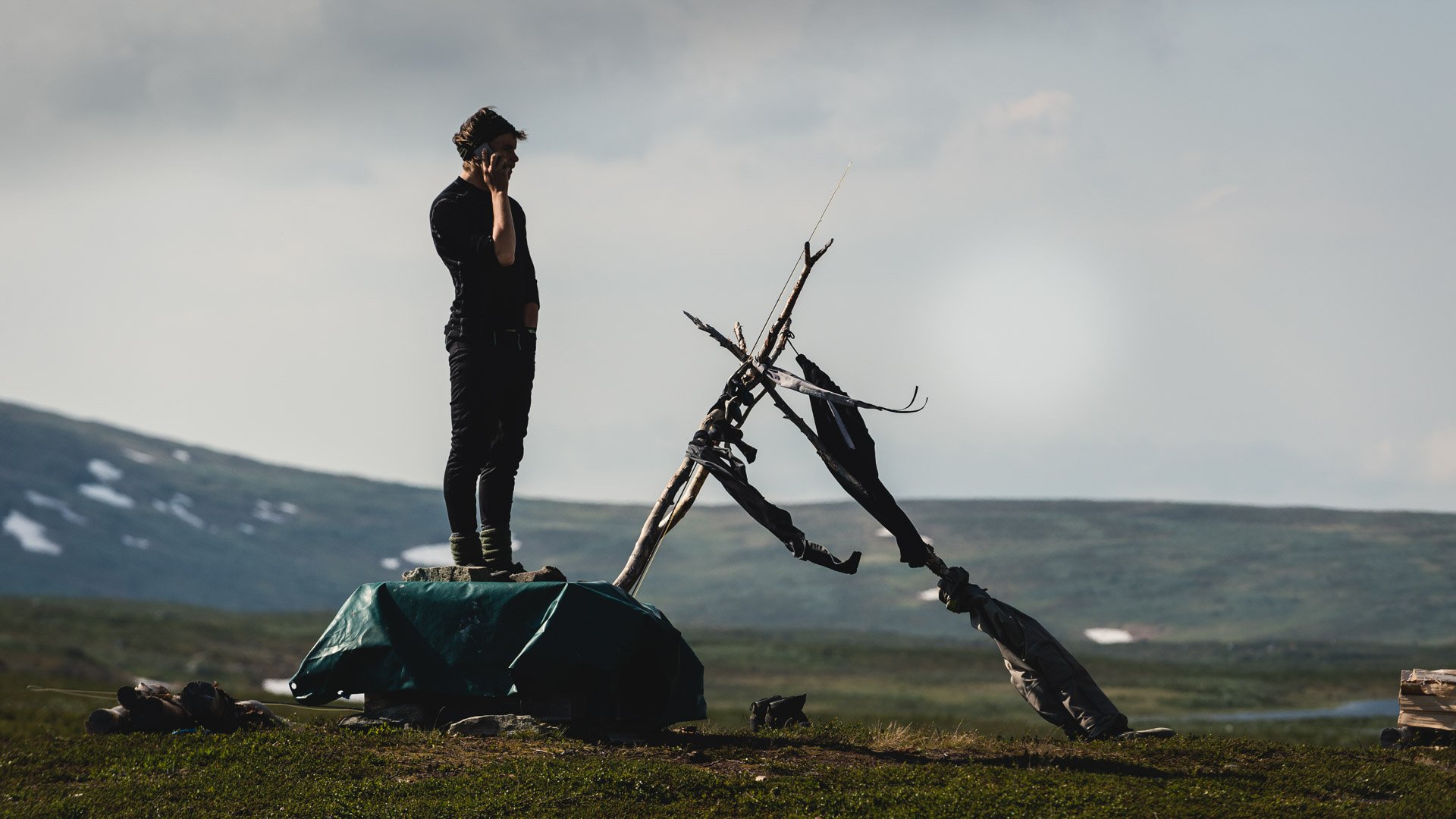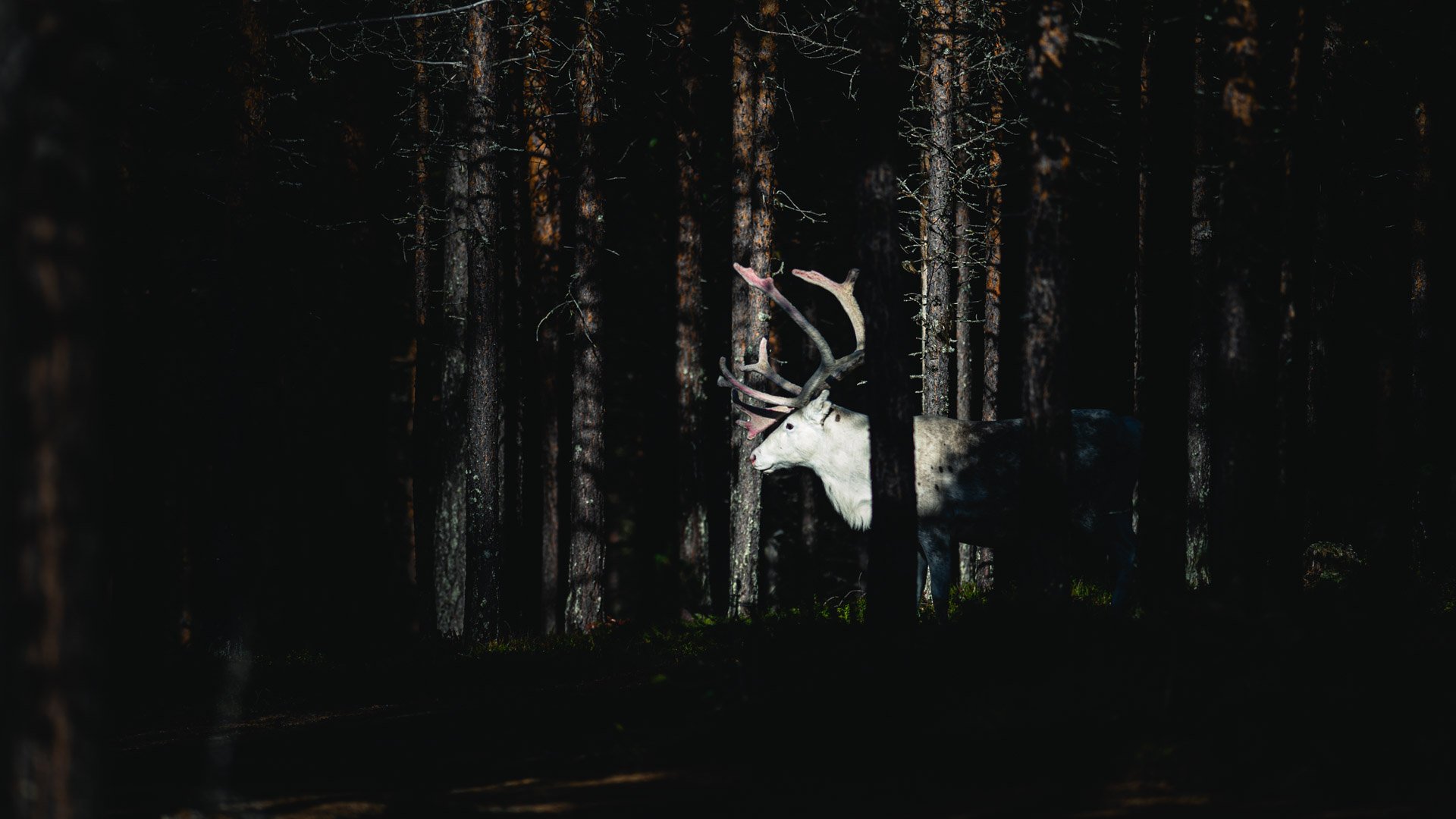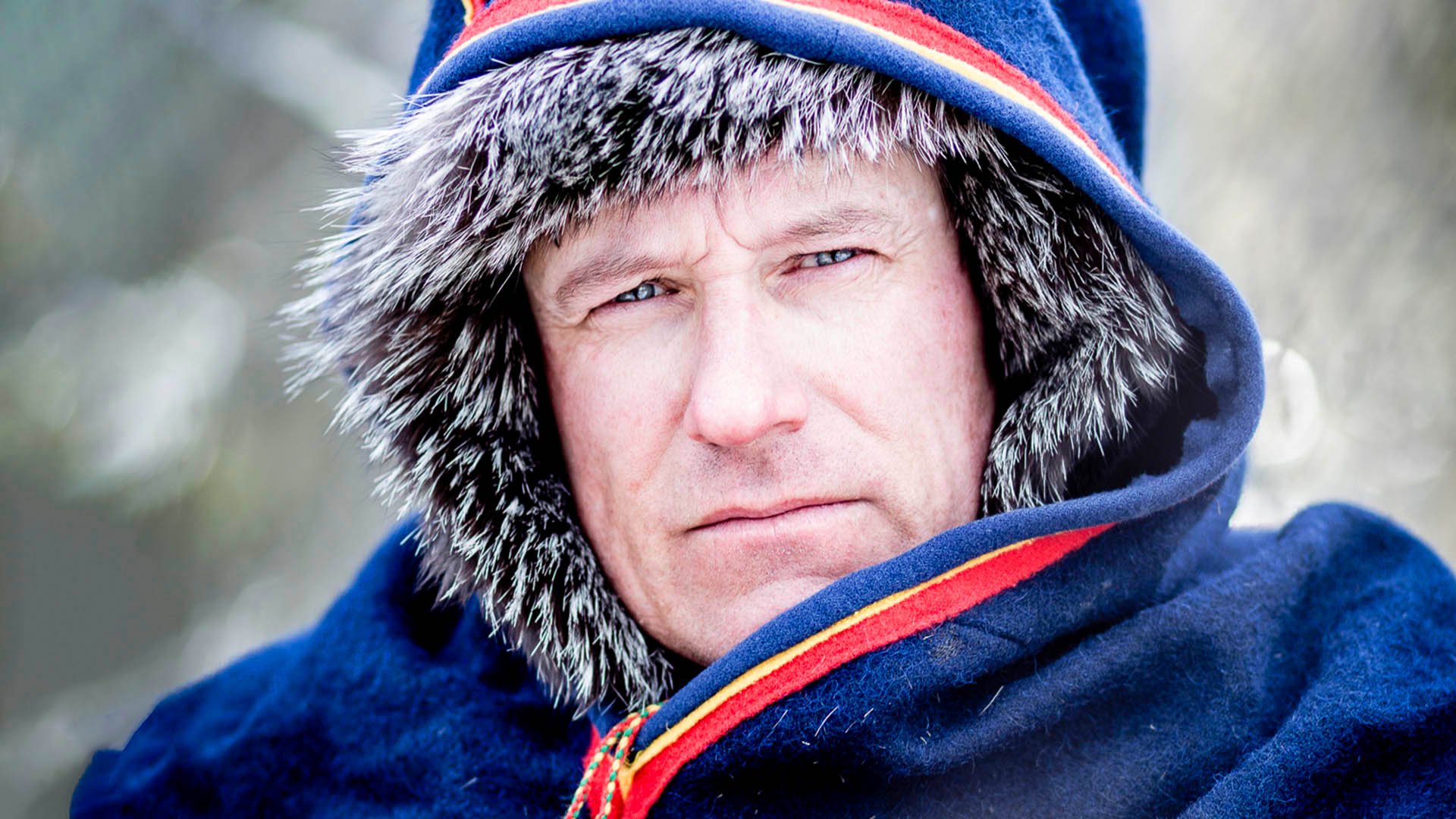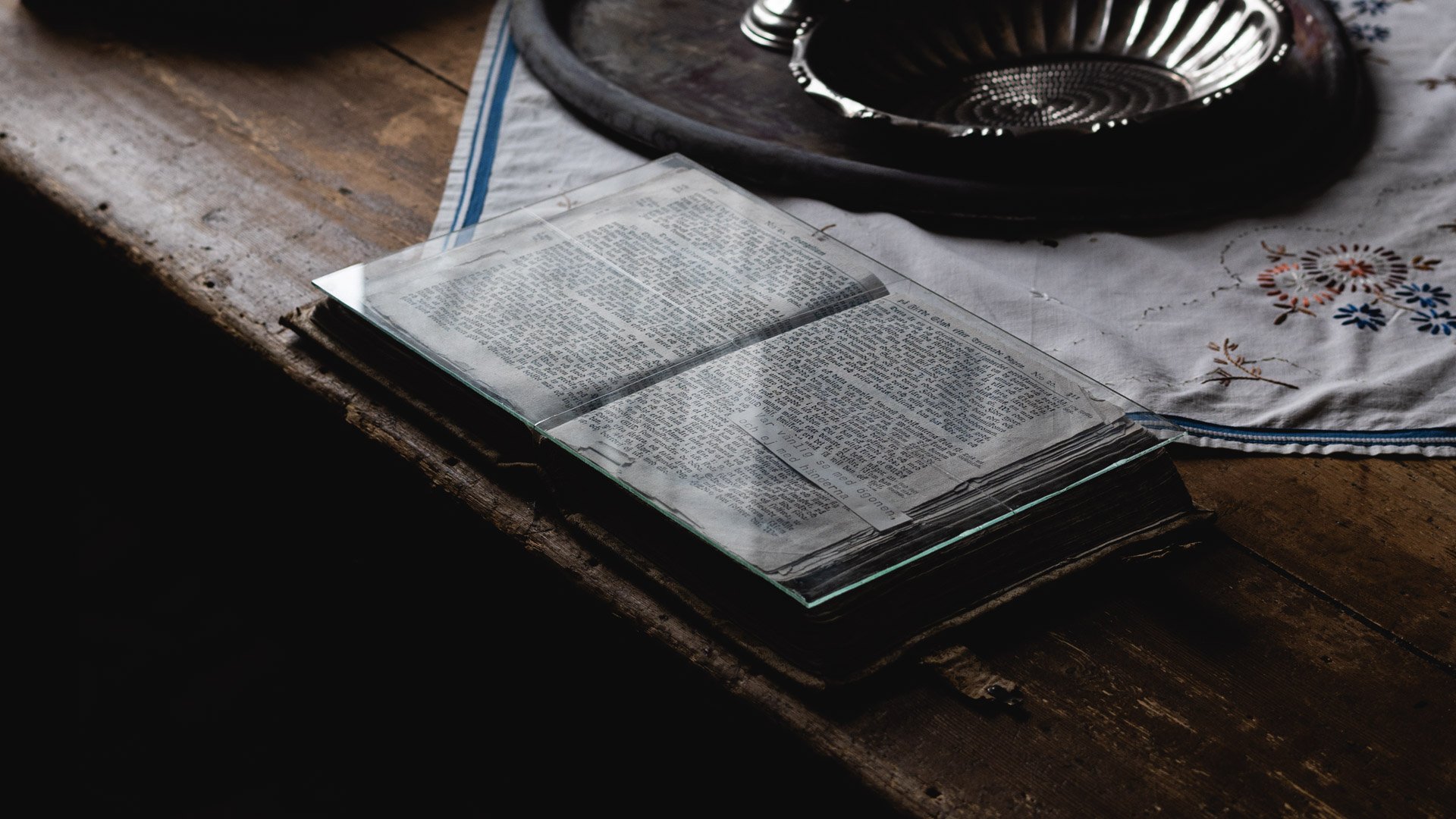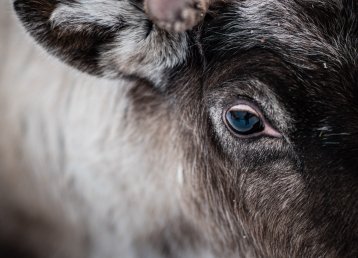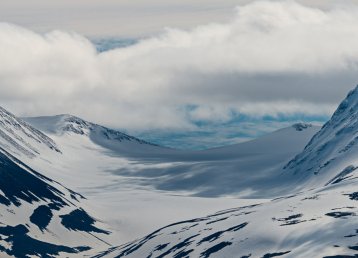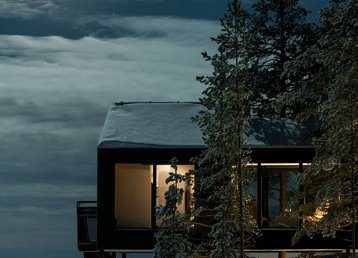There are hundreds of Sami companies – guides, craftsmen, chefs – in the destination we call Swedish Lapland. Individuals and entrepreneurs who want nothing more than to convey part of their Sami story. Because the Sami don’t just have the one story: just like any place, culture or setting, every individual has their own story, and that story becomes part of a larger whole. Whether you want to immerse yourself in a strong cultural life, experience exciting adventures in nature, or savour some of the best gastronomy Sweden’s Arctic has to offer, the Sami tradition is a big part of your northern journey. In every possible way, it’s impossible to imagine an Arctic lifestyle without the Sami included.
Through Sápmi
Into traditions and history. Into lifestyle and culture.
1. Ammarnäs—Sorsele: 88 km
We fill our car up in Ammarnäs, or Gávtjávrrie as it’s called in Ume Sami, before heading off on our trip. The petrol station is adjacent to Anders Skum’s shop Fjällvilt, and since the shop is open, we take the opportunity to buy some dried reindeer meat, smoked inner thigh and gurpi sausage, as well as fresh, thinly sliced reindeer meat known as renskav. The new Nordic cuisine might have revolutionised the world in many ways with all its smoked, dried, pickled and salted flavours, and food cooked over an open fire, but this is the culinary tradition that has always existed here, in Sápmi and the Arctic. Drying, salting and smoking was how nomads were able to preserve and bring their food with them. Unless they ate it fresh, cooked over a fire, of course.
Also read
An unforgettable mealGávtjávrrie is located where the rivers Tjulån and Vindelälven meet, in a delta ideal for birdlife and birdwatchers. This marks the beginning of the Vindelälven Biosphere Reserve: Juhtátahkká. Gávtjávrrie is a cultural and natural melting pot, a place of national interest in terms of conservation of cultural environments. The area around Potatisbacken (the Potato Hill), is where Sami culture, settler culture and the church all come together – the three cultures that shaped this part of the world. All along this road trip, there’s tasty food featuring Sami traditions or ingredients. Anders Skum has been awarded medals in Swedish craft food, and other exciting northern food ambassadors and bearers of northern food traditions include Eva Gunnare in Jåhkåmåhkke, Ingrid Pilto in Gávtjávrrie and Pia Huuva in Liehittäjä. There are also plenty of abattoirs and shops that sell reindeer, fish, and other game.
2. Sorsele—Slagnäs: 30 km
90 kilometres downstream, along the Vindelälven river, is Sorsele, Suarssá in Ume Sami. Two of the best cafés on the inland road are right here: Hook and Cup is the place to go for sandwiches created by food creator Ingrid Pilto, and the Swiss café Princess, a stone’s throw away, offers a different setting. But I head off to the village church. This is where Anders Fjellner, also known as ‘the Homer of the Sami’, is buried. Fjellner began as a missionary in Karesuando and became a Sami folk poet based in Suarssá. Anders Fjellner came from the province Härjedalen and studied to become a priest in Uppsala. His mother tongue was Southern Sami, but he was taught Latin and Swedish at school. When he arrived at his first posting in Karesuando, he learned Northern Sami and Finnish. In Sorsele he wrote his most famous epos, Päiven Pardne (Sons of the Sun) in his own distinct manner, using a mixture of dialects from Jukkasjärvi and Härjedalen. This poem, Sons of the Sun, inspired the design of the Sami flag. As for Anders Fjellner, he was most likely a language genius. He corresponded with his university friend Carl Axel Gottlund in Finnish and was an interpreter of several Sami languages.
Also read
Sápmi — the land of the SámiPut simply, there are three linguistic areas in Sápmi: an eastern part, a central part, and a southern part. Eastern Sami is spoken on the Kola peninsula and around lake Enareträsk in Finland. The central Sami languages, for example Northern Sami and Lule Sami, are spoken in Sweden, Norway, and Finland. Southern Sami is spoken in both Norway and Sweden. When it comes to Sami languages, country borders have no relation to linguistic borders, and the languages are changing as a result of both forced displacements and today’s voluntary movements. The difference between the ‘outer borders’, so to speak, from south to east, could be compared to the difference between Swedish and German. At present, some Sami languages are experiencing a revival. This is the case for Ume Sami and Pite Sami, for example, languages that belong to the southern part of the central Sami linguistic area.
Sami Museums
Would you like to immerse yourself in all things Sami travelling along these roads?
Silvermuseet in Árjapluovve >>
Ajtte svenskt fjäll- och samemuseum in Jåhkåmåhkke >>
Länskonstmuséet in Giron >>
3. Slagnäs—Arjeplog—Arvidsjaur: 145 km
Driving north along the E45 we turn off at Slagnäs to visit the Sami cultural centre Båtsuoj. The Svensson family has run a tourism business here for decades, but their Sami traditions go back centuries, and the focal point of the entire activity – the reindeer – has existed in the Arctic environment for millennia. The reindeer is completely adapted to its Arctic environment, with a fur that is made for the cold: a strand of reindeer hair is hollow, which means it is ideal for insulation. The reindeer muzzle functions as a heat exchanger, and the eyes change their perception of light from one season to the other. From the midnight sun in summer to the polar night in winter, the reindeer’s eye colour changes from brown to blue.
There are several places within the destination where you can visit the Sami and their reindeer: to learn, and to meet. Lotta Svensson in Båtsuoj and Nils Nutti in Jukkasjärvi are a two of these places centred on the reindeer and learning about the Sami culture. Another detour from the E45 is a visit to the Silver Museum in Arjeplog/Árjapluovve (Pite Sami). This museum is a knowledge portal in the Arctic cultural landscape and features classic exhibitions as well as space for exciting research projects on the Sami cultural landscape. Other museums to visit are the national museum Ájtte in Jåhkåmåhkke and the county art museum in Giron.
The chef and the herder
The chefs at Mathias Dahlgren and reindeer herders outside Arvidsjaur join forces trying to find new uses for reindeer.
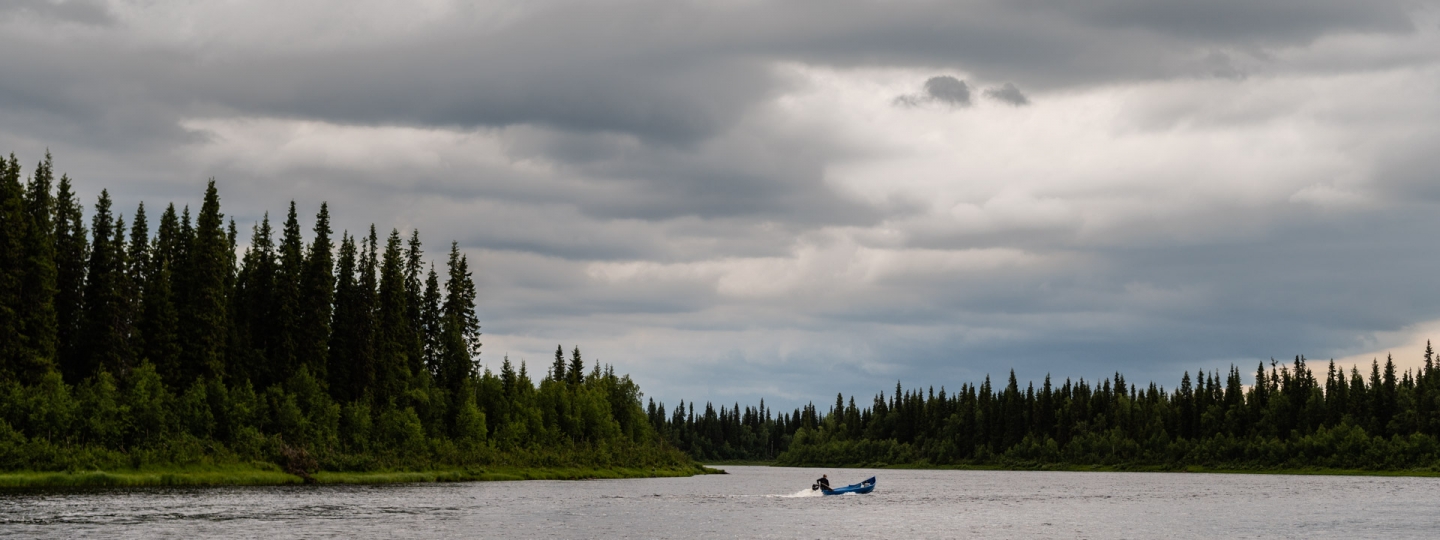
The church tour
There are 16 preserved church towns in Sweden, 13 of them in Swedish Lapland. Árviesjávrrie church town was a place where the Sami would gather at least twice a year: the first weekend in June and the last weekend in August.
4. Arvidsjaur—Jokkmokk: 154 km
Back on the E45 we make a stop in Arvidsjaur/Árviesjávrrie, visiting the church town called Lappstaden in Arvidsjaur. Forcing Christianity on the Sami, assimilating them into the Swedish system, began when the state and the church could start charging them taxes. Since it was difficult to gather all these nomads, church towns were built in central places, arranging for sermons, trade, and taxation to take place on set dates. Árviesjávrrie church town was a place where the Sami would gather at least twice a year: the first weekend in June and the last weekend in August. The houses and traditional huts in the Sami church town are all private. Within the destination Swedish Lapland you will find 13 out of Sweden’s 16 preserved church towns. Gammelstads Kyrkstad outside Luleå is the largest and most well-known, and also included on the UNESCO World Heritage List. Árviesjávrrie church town faced demolition threats in the 1930s when a new road was to be constructed.
Karin Stenberg, a Sami teacher and front runner of the association movement, was committed to stopping the road work. She succeeded. Karin Stenberg had formed the Sami Association of Arvidsjaur already back in 1916, the first of its kind. She founded the Sami adult education centre and the important national organisation called Same Ätnam. Karin Stenberg was a highly regarded political force and went on to receive several medals, among them a Royal Patriotic Society Medal. Same Ätnam is the founder of the Sámi Duodji handicraft organisation, the Samefolket Foundation and the Ájtte Museum, as well as the Sami Education Centre, among other things. Karin Stenberg was a strong woman in a patriarchal world, but she was not alone. Others, such as the midwife and feminist Elsa Laula Renberg from Vilhelmina, had paved the way. Elsa Laula co-founded the first Sami national meeting on February 6, 1917. This is the date that is now celebrated as the Sami National Day.
Sámi Duodji
Sámi Duodji supports development through courses and scholarships aimed at Sami craftsmen and artisans, for example. Their activities cover the whole of Sweden, and the emphasis is on managing Sami handicraft in the best possible way, creating knowledge about, and developing, the Sami cultural heritage.
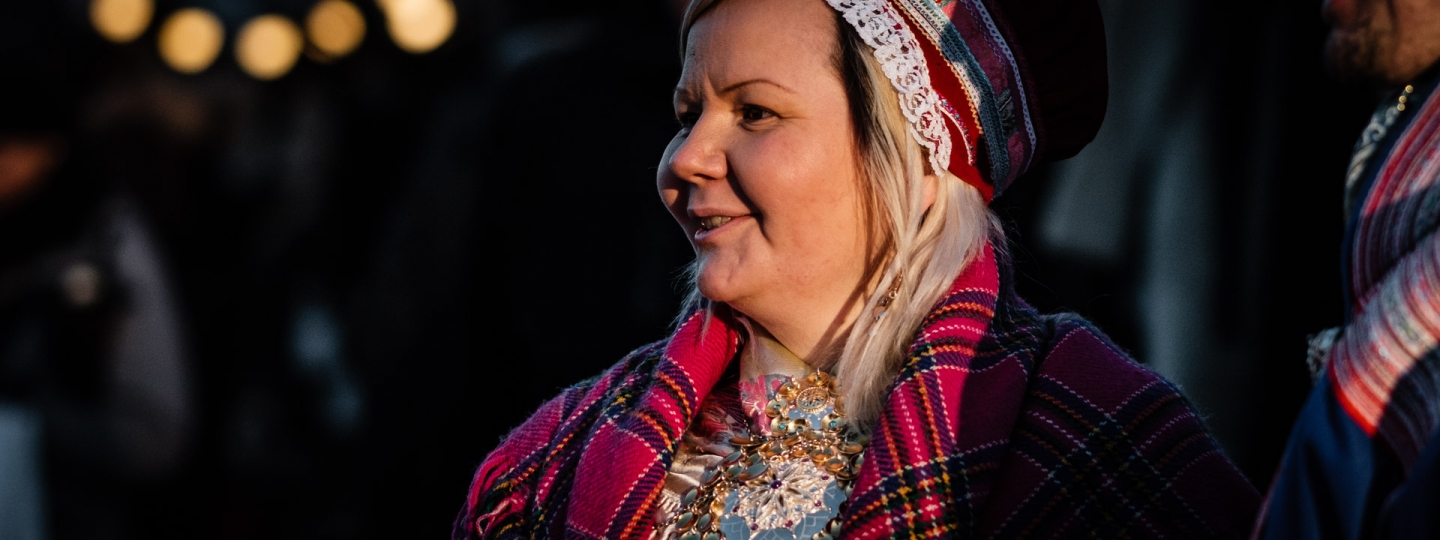
A meeting place for 400 years
The Jokkmokk Market is a winter market held annually for more than 400 years in Jokkmokk. It always starts on the first Thursday of February.
5. Jokkmokk—Kiruna: 214 km
The market in Jokkmokk/Jåhkåmåhkke (Lule Sami) has been an annual event since 1605. That means more than 4oo years of physical meetings, and, during the pandemic, a few digital events. This market in Jokkmokk, always starting on the first Thursday in February every year, is one of the strongest brands in northern Sweden. In many ways, the market makes Jokkmokk the unofficial capital of Sápmi. Jåhkåmåhkke has the largest number of Sami per capita: more than 15 per cent of Jokkmokk’s population was entitled to vote in the Sami Parliament elections. The Ájtte Museum is one of two national museums outside the Stockholm area, and one of the best places to learn more about Sami culture. The exhibition on Sami handicraft curated by Kristina Spiik Skum and Sunna Kuoljok is one of the largest handicraft exhibitions in the world, and an amazing visitor experience.
Also read
Jokkmokk's MarknadThere are many other Sami exhibitions, artists and creators for you to enjoy in Jokkmokk. Sámi Duodji has an exhibition and a shop in town, and the Sami Adult Education Centre – Samij Åhpadusguovdásj, ‘Samernas’ in short, is located right in the centre. It’s a well-known fact that many of today’s foremost artisans, designers and artists within Sami culture have trained here. There are also several famous brands here in Jåhkåmåhkke, such as Jokkmokks Korv, Jokkmokks Tenn and Care of Gerd. They have little or no Sami connection but are well worth a visit even so.
Jokkmokk’s marknad
The Jokkmokk Market is a winter market held annually in Jokkmokk. It starts on the first Thursday of February and runs until the following Saturday.
6. Laponia
We head further north. Just outside Jåhkåmåhkke is Akkats power plant with a dam where artists Lars J:son Nutti, Bengt Lindström and Lars Pirak have created the artwork Uvssat davás, or ‘the Doors to the West’. From here, views open up into World Heritage Laponia while the power plant itself offers a clear picture of another side to Sápmi: the area as part of the Nordic States’ power and, according to many, colonisation. Some ten kilometres later you can turn west towards Årrenjarka and Kvikkjokk, classic places to visit in the mountains. The world’s longest ski race, Red Bull Nordenskiöldsloppet, pass through here every year in memory of two Sami skiers from the area who were fellow travellers on Nordenskiöld’s Greenland expedition. Travelling further north along the E45 there’s a turn after Bårjås/Porjus towards another entrance to Laponia, the one that takes you to Stuor Muorkke/Stora Sjöfallet.
Also read
Laponia — the world heritageReindeer owner Lennart Pittja runs his camp Sápmi Nature in the village Nabreluokkta. Lennart is one of many Sami who have chosen a different life than that of a reindeer herder. He works with tourism and visitors. Lennart’s mission is to educate visitors on Sami culture. He often states: “There is no Sami story for everyone; every Sami has their own story”. For example, he says people sometimes ask why he doesn’t wear traditional Sami clothing when it’s cold, but instead a regular snowmobile overall. Then he tells them that: “Yes, the traditional clothing is really important to me, and to Sami history. But sometimes Gore-Tex is a lot better, and I choose to dress so I don’t have to be cold. I’m not Sami because I look a certain way; I’m a Sami because that’s what I am. It’s my heritage, it’s not what I wear.”
A hymn to home
At Nabreluokkta raindeer herder Lennart Pittja runs Sápmi Nature, by National Geographic crowned one of the best places to visit up north.
7. Kiruna—Jukkasjärvi: 19 km
Visiting Giron/Kiruna, a detour from our chosen E45, a visit to the new City Hall Kristallen (the Crystal) and its county art museum is a must. Giron means rock ptarmigan in Northern Sami, and it’s a city in the process of moving. The mine underneath the city is extending, causing this urban transformation. Migration and relocation are of course a part of Sami everyday life: moving between winter and summer workplaces, always following the reindeer – this has always been a natural part of Sami existence. Nutti Sámi Siida in Jukkasjärvi offers Sami tours and programs along with its Márkanbáiki – a Sami outdoor museum – that give a good insight into Sami culture, life near the reindeer. Nutti Sámi Siida is located next to Jukkasjärvi church, and a stone’s throw from Icehotel.
Jukkasjärvi is called Čohkkiras in Northern Sami, and it means ‘meeting place’. Inside the church in Jukkasjärvi you can admire a couple of paintings made by Bror Hjort, featuring Lars Levi Laestadius. We’ll get back to Laestadius. In Kiruna, designer Sara Björne has her studio. Sara Björne’s clothing/sewing is Sámi Duodji reaching a wide market: her clothes have been worn by Swedish ministers and award-winning scriptwriters and directors at ceremonies all over the world. If you know your Sami clothing, the formal wear and its embellishments let you know where the wearer is from. In the beginning, as can be expected, it was made of reindeer skin. Fabrics started to be traded when the Norwegian coast – mainly – became a trade route. The reindeer was the main commodity for the Sami, but handicraft was also important. In Northern Sami the traditional clothing is galled gákti and is often dark blue. The male and female gákti often match. In the South Sami area, it’s called gápta and is often lighter blue or black. The difference between male and female clothing tends to be greater in this area.
Nutti sámi siida
In the village of Jukkasjärvi, at Nutti Sámi Siida, you can meet reindeer, eat a good lunch, have a coffee, but above all: learn more about the culture surrounding reindeer husbandry.
7. Jukkasjärvi—Övre Soppero: 119 km
After our detour to Kiruna, we’re once again driving on the E45. In Övre Soppero we drive past Britta Marakatt-Labba’s house. Britta is a textile artist who has embroidered resistance art since the 1970s – a kind of graffiti for the meek. Her first artwork to gain attention is called Garrját, ‘The Crows’, and it was created during the protests against the Norwegian state’s development of the Alta River. She embroidered her most famous work Historja between 2003 and 2007 in her studio. The entire artwork is 24 metres long and embellishes the university in Tromsø.
Also read
Embroidering resistance artSami history existed in stories and pictures. The written language came late and really only once the national states tried to take the Sami language away from the Sami through nomad schools, and once the church tried to remove their faith. The Swedish Church has recently apologised for its abuse of the Sami people. Other than Britta Marakatt-Labba there are many Sami artists who have made an impression in culture: Anders Sunna exhibits at the Biennale in Venice, multiple-award-winning director Amanda Kernell made the film Sami Blood, and there are numerous authors – Linnea Axelsson with Ædnan, Ann-Helén Laestadius with Tio över ett, and Elin Anna Labba with Herrarna satte oss hit have all won the August Prize. Elin Anna Labba’s book is about the forced displacement of the Sami, from the north to the south. It’s a dark chapter in Sami and Swedish history. The Skum family for example, who we met in the beginning of this story, originally came from Sárivuoma in the north; they spoke a completely different language to the Ume Sami spoken in Gávtjávrrie. Ander’s dad Per told the story about how he and his family had to live in the stable outside the hotel in Suarssá when they were forcibly transferred south from Sárivuoma Sami village.
8. Övre Soppero—Karesunado: 52 km
The journey north ends in the village of Karesuando. On the other side of the bridge is Finland. The Torne Valley is a mix of cultures: Sami, Swedish, Finnish, but also – in every way – this is a culture of its own. If we add further layers, the church and the state were influencing forces. Lars Levi Laestadius, of Sami descent from Arjeplog, became one of the strongest reformers of the church. He grew up destitute, in a dysfunctional home, and actually wanted to become a botanist. He was part of the French expedition La Recherche to the Arctic and wrote several papers on animals and botany. His participation in the expedition earned him the French Legion of Honour Medal, but he ended up becoming a priest. Since he knew Sami (Pite Sami), the Swedish Church placed him as a missionary in the ‘Land of the Laps’. Laestadius worked in Karesuando for much of his life, and his pörte (cabin) is still there. The revival movement started by Laestadius in the middle of the 19th century became known as Laestadianism and is still a strong part of the Swedish Church in the northernmost part of the country. Above all, this movement countered the increasing alcoholism that was spreading in the north, causing mismanagement of reindeer herds and trade breakdown as it ruined people’s lives. Sami as well as settlers were basically drinking their lives away. The Swedish Church was an instrument in the colonising of Sápmi and the oppression of the Sami people – something that the Church has apologised for – but the church and the clergy also featured positive personalities, such as Laestadius’s work against widespread alcoholism and Fjellner’s work on Sami story. As with most things in life, there are no simple answers.
Laestadianism
Laestadianism is a Lutheran revivalist movement within the church. The movement is named after Lars Levi Laestadius (1800–1861), who was a priest in the parishes of Pajala and Karesuando, among other places. His sermons of repentance gave rise to a revival that spread rapidly across the Cap of the North, changing many peoples’ lifestyle and reducing alcohol abuse, not least among the Sami. The movement has since spread across to North America as well, and it’s most prevalent in Finland.
9. Karesunado—Pajala: 187 km
Ran, Gran, Svaipa, Maskaur, Semisjaur – Njarg, Sirges, Unna Tjerusj, Girjas, Vittangi. We turn east off the E45, onto road 99 towards Pajala. We travel from Sweden’s northernmost Sami village, Könkämä, down through the forests towards the coast. From the more nomadic reindeer herding in the mountains – where the migration route between summer and winter grazing is longer – through the forested area where more stationary reindeer herding prevails, to Sami villages based on a so-called right of concession. In Sweden there are 51 Sami villages: 33 are mountain Sami villages, 10 are forest Sami villages, and 8 are operated in the forested area with concession rights.
A Sami village is run like an economic association that organises reindeer husbandry, and it’s a geographical area used for reindeer grazing, and for hunting and fishing. In other words, a Sami village is not a community inhabited only by Sami, as many might think based on the term, rather it’s a way of managing the industry in a geographical area. These days there are probably more Swedes who can name America’s different indigenous people, or nomadic tribes in Africa, than can name the Sami villages in Sweden.
10. Pajala—Liehittäjä: 131 km
In the village Liehittäjä, with the Huuva family, is where this journey ends. Liehittäjä is one of Sweden’s eight concession Sami villages, where the right to practise reindeer herding is held by a person with a special permission. The eight concession villages are located in eastern Norrbotten, in the area between Kalix and the Torne River Valley. The reason these villages came about is that reindeer husbandry was indeed carried out here, but missed by the Swedish government when the so-called ‘Lapland border’ was drawn. The Huuva family operate their reindeer husbandry as well as a tourism company in Liehittäjä. Huuva Hideaway is a wonderful and low-key option for those looking for world-class glamping.
Pia and Henry Huuva serve up a first-class experience where food and storytelling are in focus. Liehittäjä is the north-easternmost Sami village in the country, down towards the Haparanda coast. In every way Sweden’s Arctic story would not have existed without the Sami culture, without life in Sápmi. As Sweden’s Arctic destination, Swedish Lapland would have been pretty lacklustre without its rich Sami culture. When Pia Huuva serves dried reindeer meat and nettle soup with fried willowherb stems in Liehittäjä, it’s a meeting of several cultures, which is what we’ve been trying to capture. A Sami culture and a Sami life, a recognised indigenous people, but still in a conglomerate of other migrants, created by modern life. Even if nothing ever stands still, it does have an origin. Pia Huuva offers me a gin and tonic. I gratefully accept but can’t help thinking what Laestadius would have said. About all this.
Also read
More road trips in Swedish LaplandEating out
Huuva Hideaway is located in the tiny village Liehittäjä, in the Torne Valley. This is a place to experience genuine Sami culture and amazing dining experiences based on surrounding nature.



















